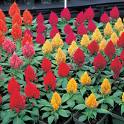 Cockscomb is a tender perennial native to tropical areas of Asia, Africa, and America and a member of the amaranth family, Amaranthaceae, that also includes beet, spinach, and Gomphrena. Growing 6-30″ tall, plants have alternate green to burgundy leaves that are usually narrow and entire. The flowers appear in feathery terminal or axillary spikes that are 4-12″ long and a bright orange, scarlet or yellow. Many cultivars are available that vary most significantly in flower and foliage color as well as height and length of flower plume. The feathery blooms add a soft texture and upright form to the garden when many other plants are mounds of round, many-petaled flowers. The plants love heat and start blooming as soon as temperatures are warm. They continue blooming all summer adding color at times when many other plants stop flowering. Celosia are excellent cut flowers and may be dried for use in flower arrangements. The genus name, Celosia, comes from the Greek word keleos meaning burning and refers to the brilliant color of the flowers. the specific epithet, argenteae is the Latin word for silvery and refers to the sparkling color. The variety name, plumosa is the Latin word for feathery and refers to the flower plume.
Cockscomb is a tender perennial native to tropical areas of Asia, Africa, and America and a member of the amaranth family, Amaranthaceae, that also includes beet, spinach, and Gomphrena. Growing 6-30″ tall, plants have alternate green to burgundy leaves that are usually narrow and entire. The flowers appear in feathery terminal or axillary spikes that are 4-12″ long and a bright orange, scarlet or yellow. Many cultivars are available that vary most significantly in flower and foliage color as well as height and length of flower plume. The feathery blooms add a soft texture and upright form to the garden when many other plants are mounds of round, many-petaled flowers. The plants love heat and start blooming as soon as temperatures are warm. They continue blooming all summer adding color at times when many other plants stop flowering. Celosia are excellent cut flowers and may be dried for use in flower arrangements. The genus name, Celosia, comes from the Greek word keleos meaning burning and refers to the brilliant color of the flowers. the specific epithet, argenteae is the Latin word for silvery and refers to the sparkling color. The variety name, plumosa is the Latin word for feathery and refers to the flower plume.
Type: Tender perennial
Bloom: Summer.
Size: 6-30” H x 8-18” W.
Light: Full sun.
Soil: Well drained.
Hardiness: Zones 10-11
Fertilizer: In mid summer apply a fertilizer in the ratio of 1-2-2.
Care: Deadhead faded flowers every 2 weeks.
Pests and Diseases: Root rot may occur in clay soils and/or during rainy weather. Remove infected plants immediately.
Propagation: Sow seed once the soil has warmed; use transplants for earlier bloom.
Companion plants: moss rose (Portulaca grandiflora), Verbena ‘Homstead Purple’, Globe amaranth (Gomphrena globosa), Periwinkle (Catharanthus roseus).
Outstanding Selections: Castle series (8” yellow, pink, scarlet, or orange plumes on 12” plants), “Apricot Brandy’ (apricot-orange feathers on 18-24” plants).
Comment: Cut stems for drying when young and hang upside down in a dry dark place.
